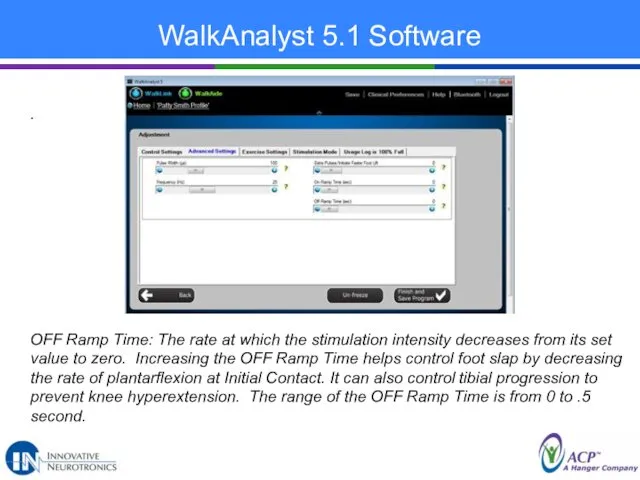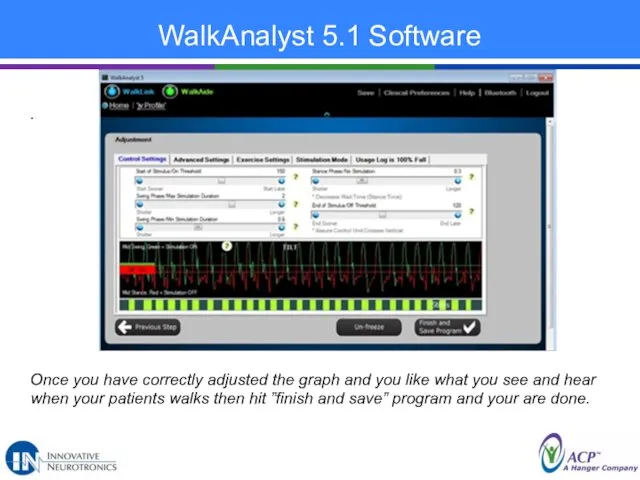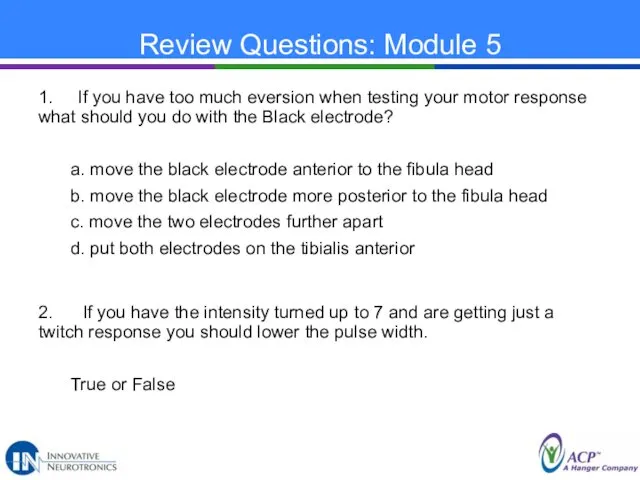Содержание
- 2. FES has been used in rehab for decades. Previously there were preferred conventional alternatives (i.e. AFO)
- 3. Changes in types of stimulation have improved comfort and performance. Waveforms are more similar to physiologic
- 4. CNS after injury has all the tools necessary to restore function, but no plans or blueprints!
- 5. Utilization of a Neuroprosthesis vs. an AFO AFO WalkAide Improve stability x x Improve mobility x
- 6. Research Supporting FES in used for Neurorehabilitation
- 7. What are the outcomes noted in the literature? Decrease in abnormal tone Measured by physiologic measures
- 8. What is the support for proposed FES outcomes? Support for improved gait outcomes post FES Increased
- 9. Support for improved gait outcomes post FES Increased Symmetry of swing and stance phases Changes seen
- 10. Support for improved gait outcomes post FES Increased endurance / decreased physiological cost Moderate support is
- 11. Support for facilitation of neuroplastic changes Carry over effects post FES These have been noted since
- 12. Support for facilitation of neuroplastic changes Normalized spinal reflexes Two studies have shown normalization of spinal
- 13. We can provide you with complete clinical study summations, bibliographies and the actual clinical studies upon
- 14. Indications, Contraindications and Considerations Indications: UMN lesions Contraindications: LMN lesions (ie. peripheral nerve damage from injury,
- 15. Appropriate patients: presentation of signs and symptoms Other considerations: Presence of other electrically controlled devices Baclofen
- 16. Which of the following patients would not be an appropriate candidate for the WalkAide? a. CVA
- 17. The WalkAide facilitates neuroplasticity by producing appropriate, repetitive muscle contractions during a functional task and by
- 18. FES and Functional Recovery after Central Nervous System Injury and Disease Module 2: WalkAide® System
- 19. Types of Waveforms
- 20. How are the Waveforms Used?
- 21. Waveforms – patient responses
- 22. Types of FES foot drop Technologies Bioness L300
- 23. Types of FES foot drop Technologies XFT
- 24. Types of FES foot drop Technologies Neucognic
- 25. Types of FES foot drop Technologies Pace Odstock Medical
- 26. Types of FES foot drop Technologies WalkAide
- 27. Keep in Mind The WalkAide is not an instant cure. The best clinical outcome is attained
- 28. Patient Subsets You will see three subsets of patients when you are working with the Walkaide.
- 29. It takes time!
- 30. Design Criteria Self-contained Built-in sensors Self-aligning Comfortable Low-profile Lightweight Adaptations for visual and hearing impaired users
- 31. Bi-Flex Cuff Easy to fit Self-aligning Light-weight & comfortable One-hand donning/doffing Electrode markers for placement Adjustable
- 32. Dorsiflexion of the ankle at the optimal time during the gait cycle to improve limb clearance
- 33. Peripheral Nerve Stimulation Controlled amounts of electrical currents are applied to the Peroneal Nerve in order
- 34. Unique Design Features: Inclinometer Tilt ON Threshold Tilt OFF Threshold Measures tilt angle from a vertical
- 35. Accelerometer Measures changes in speed of movement Allows WalkAide to adapt to variations in gait speed
- 36. Sophisticated patient management software that analyzes individual walking data and selects customized programming for optimal outcomes
- 37. WalkAide Customization – Combo Therapy – Knee Brace/AFO
- 38. WalkAide Customization - Silicone
- 39. WalkAide Customization – Pediatric Cuffs
- 40. WalkAide Customization – Adult Cuffs Carbon Fiber Cover Customized cuff for an extra large calf
- 41. WalkAide Accessory – Silicon Cover
- 42. WalkAide is Unique Patient Benefits Adapts to step length & speed variations Facilitates sagittal plane swing
- 43. Upper Motor Neuron Deficits Incomplete Spinal Cord Injury (iSCI) Traumatic Brain Injury (TBI) Stroke (CVA) Multiple
- 44. Peripheral Nerve Damage (examples) Secondary complications of back, hip or knee surgery Traumatic accidents to the
- 45. Review Questions - Product Overview Module 2 The WalkAide® System is Neuroprosthetic technology that utilizes peroneal
- 46. Review Questions - Product Overview Module 2 The WalkAide adapts to step length and speed variations
- 47. Module 3: Therapeutic Effects
- 48. The effect of FES on sensorimotor function Stimulation of motor nerves creates feedback. Proprioceptive and kinesthetic
- 49. The effect of FES on sensorimotor function Stimulation of spinal interneurons affects the contractile state of
- 50. The effect of FES on CNS tone management The restoration of the reciprocal inhibition reflex is
- 51. Summary At the least, FES can: Decrease compensations during gait training Facilitate swing appropriately and consistently
- 52. FES Skin Irritation
- 53. FES Skin Irritation
- 54. FES Home Exercise Program
- 55. Upper Motor Neuron Deficit Gait Dysfunction / Dropfoot GMFCS: I-III (IV) Gross Motor Function Classification System
- 56. Pediatric Candidates – GMFCS I-III
- 57. Treatment Balance Mobility vs Stability Maximum Function vs Deformity Prevention Manage Deformity vs Influence Recovery
- 58. Prevent Deformity Prevent or Delay Surgery Promote Motor Learning Substitute Involuntary Control Prevent learned non-use Reduce
- 59. Kid-Friendly Programming Options The New Pediatric WalkAide® System Pediatric Parameters provide a well-tolerated stimulus Adjustability in:
- 60. Kid-Friendly Electrode Options Smallest FES electrodes available Well-tolerated and durable 1.25” Standard and Premium Options 1.87’’
- 61. 1. Restoring the reciprocal inhibition reflex does which of the following? a. Allows for inhibition of
- 62. 3. It is okay to continue using the WalkAide if you have skin irritation as long
- 63. FES and Functional Recovery after Central Nervous System Injury and Disease Module 4: Building a Successful
- 64. WALKAIDE BRANDING Educate the entire office on the WalkAide. Have them try it on. The whole
- 65. WALKAIDE BRANDING Always think WalkAide first during a foot drop evaluation. Stim first and brace second.
- 66. YOUR WALKAIDE EQUIPMENT Have a dedicated laptop for the WalkAide. Medical device software sometimes do not
- 67. ENHANCE CLINICAL OUTCOMES Adopt the Home Assessment Program. What is the HAP? Almost 60% of the
- 68. FES and Functional Recovery after Central Nervous System Injury and Disease Where are the Patients?
- 69. THE FOOT DROP MARKET IS HUGE! 14% of the United States is over age 65. Median
- 70. CREATE A MARKETING PLAN Utilizing your RSS in the development of your marketing program is essential.
- 71. CREATE A MARKETING PLAN
- 72. CREATE A MARKETING PLAN You must take at least a half day per month to market
- 73. CREATE A MARKETING PLAN The role of the RSS: The RSS will offer on-going clinical and
- 74. CREATE A MARKETING PLAN What is IN Inc. doing for Marketing: Direct to consumer ads in
- 75. WALKAIDE PEDIATRIC MARKET If anyone is going to purchase a WalkAide, it will be a parent
- 76. WALKAIDE PEDIATRIC MARKET Set up an on-going Gait Clinic or WalkAide Screening Clinic:
- 77. CREATE SOME WALKAIDE CLINICS Gait Clinics, Referral Model (at the Physician or Physical Therapy Center).
- 78. WalkAide Billing Codes for Reimbursement WalkAide® System E0770 *This code represents the ‘Patient Kit’, including the
- 79. WalkAide Modality & Coding for Rehab *Examples of billable codes for treatment involving WalkAide
- 80. Medicare Reimbursement Medicare approved coverage for WalkAide as treatment for the diagnosis of iSCI on 1/1/09.
- 81. WALKAIDE REIMBURSEMENT Medicare: iSCI Medicaid VA, DOD and Tricare Vocational Rehabilitation Workers Compensation Private Pay Auto
- 82. WALKAIDE FINANCIAL DISCUSSION Who will have that discussion? This can be a clinician, an OA or
- 83. WALKAIDE FINANCIAL DISCUSSION Make it real life to them. Crossing the street when the light changes.
- 84. WALKAIDE FINANCIAL DISCUSSION AFO WalkAide Improve stability x x Improve mobility x x Improve strength and
- 85. WALKAIDE FINANCIAL DISCUSSION How can you put a price on the ability to walk? The WalkAide
- 86. WALKAIDE FINANCIAL OPTIONS AND FUNDING RESOURCES WalkAide Fundraising Guide Payment plan options (i.e. CareCredit) Local, state
- 87. WALKAIDE FINANCIAL OPTIONS AND FUNDING RESOURCES One Women’s WalkAide passion: Daisy Vega not only paid for
- 88. Review Questions: Business Module 4 Which are the major reasons that more WalkAides are not sold?
- 89. Review Questions – Business Module 4 To make my WalkAide program successful I need to: a.
- 90. Introducing WalkAnalyst 5.1 A faster, easier way to program.
- 91. WalkAnalyst 5.1 is designed to be quick, simple, customizable and effective for you and your patients.
- 92. WalkAnalyst 5.1 Download Download WalkAnlayst 5.1 from the www.walkaide.com website for FREE. From the top of
- 93. Patient Profiles Create Patient Profile – Create a profile for a new patient. Open Patient Profile
- 94. Begin Programming or Recover a Program from the WalkAide of a Current User Program – Select
- 95. Rapid+ Program or Express Programming Hover over Program to see 3 programming options. Rapid+ Program –
- 96. Stimulus Settings Pulse Width – An increase or decrease affects power and functional response. Frequency –
- 97. Express Adult Express Adult - A WalkAide program with control times adequate for most adult patients
- 98. Express Pediatric Express Pediatric - A WalkAide program with control times adequate for most pediatric patients
- 99. Adjustment, Transfer, Evaluation & Reports Re-Program – Start over to create a new walking program. Adjustment
- 100. Options to Create a New Program Hover over Re-Program to see multiple programming options when programming
- 101. Transfer Program Send Preferred Setting – Choose a past WalkAide program to send to the device.
- 102. Advanced Settings Adjust the stimulation parameters for comfort and function as needed. Pulse Width – An
- 103. Exercise Program Use or customize an exercise program to enhance strength and endurance. On Time –
- 104. Stimulation Mode Change the mode of stimulation to effectively treat the patient. Tilt Stimulation – The
- 105. Usage Log Clear Log – Clear Usage Log data that you do not wish to save
- 106. Evaluation & Reports Collect cadence, gait speed and stride length data for comparison and to show
- 107. WalkAnalyst 5.1 Software Fitting a New Patient Select Create Patient Profile. Add basic information (patient ID,
- 108. WalkAnalyst 5.1 Software During the initial fitting, you have the following programming options: • Rapid+ is
- 109. WalkAnalyst 5.1 Software Fitting a Returning Patient Open an Existing Patient Profile.
- 110. WalkAnalyst 5.1 Software Select Open Patient Profile and select one of the following options: Re-Program: Re-program
- 111. WalkAnalyst 5.1 Software Programming Options: Rapid+ and Express Programs
- 112. WalkAnalyst 5.1 Software Select the Rapid+, Express Adult or Express Pediatric option to initiate programming and/or
- 113. WalkAnalyst 5.1 Software Stimulus and motor response page: Now you place the electrodes and test for
- 114. WalkAnalyst 5.1 Software Stimulus Settings: WalkAnalyst allows you to change stimulus settings such as Pulse Width,
- 115. WalkAnalyst 5.1 Software Stimulus Settings: Pulse Width: This is the duration of each individual pulse within
- 116. WalkAnalyst 5.1 Software The longer the Pulse Width, the more motor units are recruited leading to
- 117. WalkAnalyst 5.1 Software Frequency: The Frequency is the rate at which the pulses occur per second
- 118. WalkAnalyst 5.1 Software Placement Tips: BLACK electrode - Find the spot where the response is greatest
- 119. WalkAnalyst 5.1 Software Remember: spacing the electrodes farther apart drives the stimulation deeper into the tissues;
- 120. WalkAnalyst 5.1 Software Electrode Placement Best Practice Accuracy of electrode placement is the key to the
- 121. WalkAnalyst 5.1 Software Electrode Placement Best Practice CONTINUED “Black to the back and Red ahead” is
- 122. WalkAnalyst 5.1 Software Rapid+: Click Start to begin collecting walking data. Walk at the patient’s involved
- 123. WalkAnalyst 5.1 Software (Data Collection) Select Collected Data
- 124. WalkAnalyst 5.1 Software Adjustment Setting adjustments are transferred to the WalkAide instantly and are confirmed by
- 125. WalkAnalyst 5.1 Software Control Settings
- 126. WalkAnalyst 5.1 Software Stimulation Mode: Use this tab to toggle between Tilt, Heel and Hand stimulation
- 127. WalkAnalyst 5.1 Software Usage Logs: Click on the Usage Logs tab to save and/or clear usage
- 128. WalkAnalyst 5.1 Software • Save and Clear Log saves walking data stored in the WalkAide then
- 129. WalkAnalyst 5.1 Software Manual Adjustment of the Stimulation Settings
- 130. WalkAnalyst 5.1 Software Manual adjustment of the stimulation settings can fine-tuning the swing and stance durations
- 131. WalkAnalyst 5.1 Software . • If the ON Threshold is too high, the tibia does not
- 132. WalkAnalyst 5.1 Software . Example 1: The green ON Threshold is too high. Steps occur on
- 133. WalkAnalyst 5.1 Software . Example 2: Tilt ON Threshold is too high. Stimulation occurs with each
- 134. WalkAnalyst 5.1 Software . Example 3: Tilt OFF Threshold is too low. Steps occur on the
- 135. WalkAnalyst 5.1 Software . Tilt OFF Threshold Correctly Adjusted
- 136. WalkAnalyst 5.1 Software . Control Settings (Swing Phase/Min Stimulation, Max Stimulation and Stance Phase): Swing Phase/Min
- 137. WalkAnalyst 5.1 Software . The Min Stimulation Duration may need to be decreased for a faster
- 138. WalkAnalyst 5.1 Software . The OFF Threshold overrides the Swing Phase/Max Stimulation Duration during walking to
- 139. WalkAnalyst 5.1 Software . In general, the Swing/Min Stimulation Duration, Swing/Max Stimulation Duration and Stance Phase/No
- 140. WalkAnalyst 5.1 Software . More Graph adjustment tips:
- 141. WalkAnalyst 5.1 Software . More Graph adjustment tips:
- 142. WalkAnalyst 5.1 Software . ON Ramp Time: The rate at which the stimulation intensity rises from
- 143. WalkAnalyst 5.1 Software . OFF Ramp Time: The rate at which the stimulation intensity decreases from
- 144. WalkAnalyst 5.1 Software . Once you have correctly adjusted the graph and you like what you
- 145. WalkAnalyst 5.1 Software . Final Tips: The enemy of good is perfect. Whatever you get during
- 146. Review Questions: Module 5 1. If you have too much eversion when testing your motor response
- 148. Скачать презентацию

















































































































































 Ұлттық клиникалық жетекшілік. Даму тарихы, құрастыру қағидалары мен ендіру мәселелері
Ұлттық клиникалық жетекшілік. Даму тарихы, құрастыру қағидалары мен ендіру мәселелері АИВ - инфекциясы
АИВ - инфекциясы Ранние симптомы заболеваний у хорьков
Ранние симптомы заболеваний у хорьков Психология детей с нарушениями опорно-двигательного аппарата (ДЦП)
Психология детей с нарушениями опорно-двигательного аппарата (ДЦП) Вакцинация от Сovid в вопросах и ответах
Вакцинация от Сovid в вопросах и ответах Хронические гепатиты
Хронические гепатиты Способы использования лекарственных растений и приготовление лекарственных форм из растений
Способы использования лекарственных растений и приготовление лекарственных форм из растений Инфекционный мононуклеоз
Инфекционный мононуклеоз Лекарственное врачевание в Древнем Китае
Лекарственное врачевание в Древнем Китае Принципы и методы лечения пациентов с синдромом тонзиллита. Тактика фельдшера. Дифференциальная диагностика ангин
Принципы и методы лечения пациентов с синдромом тонзиллита. Тактика фельдшера. Дифференциальная диагностика ангин Особенности межличностного общения с коллегами. Врачи Скорой помощи
Особенности межличностного общения с коллегами. Врачи Скорой помощи Гигиенические основы физического воспитания и закаливания детей и подростков
Гигиенические основы физического воспитания и закаливания детей и подростков Инородные тела верхних дыхательных путей
Инородные тела верхних дыхательных путей Морфологические элементы. Принципы лечения дерматозов
Морфологические элементы. Принципы лечения дерматозов Клещевой энцифалит
Клещевой энцифалит Портфели влияют на нашу осанку
Портфели влияют на нашу осанку Хирургическое лечение цереброваскулярных заболеваний
Хирургическое лечение цереброваскулярных заболеваний Лечение пародонта
Лечение пародонта Общий уход
Общий уход Медицина в средневековой Европе
Медицина в средневековой Европе Диагностика и современные подходы к лечению остеоартроза
Диагностика и современные подходы к лечению остеоартроза Dental caries and pulpitis
Dental caries and pulpitis Локальная атрофия мозга
Локальная атрофия мозга Гиперурикемия и подагра в свете кардиоваскулярных рисков
Гиперурикемия и подагра в свете кардиоваскулярных рисков Несеп-жыныс жүйелерінің қатерлі және қатерсіз ісігі
Несеп-жыныс жүйелерінің қатерлі және қатерсіз ісігі General Psychopathology
General Psychopathology Анатомо-физиологические и психологические особенности лиц пожилого возраста
Анатомо-физиологические и психологические особенности лиц пожилого возраста Наследственно-дегенеративные заболевания нервной системы
Наследственно-дегенеративные заболевания нервной системы